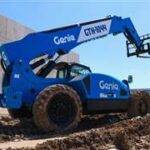When it comes to selecting the most suitable scissor lift for your project, understanding the differences between slab scissor lifts and rough terrain scissor lifts is key. Both types of lifts serve specific roles in various work environments, and choosing the right one is essential for optimal performance, safety, and cost-effectiveness.
Slab Scissor Lifts: Features and Applications
Slab scissor lifts are primarily designed for indoor applications and are ideal for smooth, flat surfaces. These lifts are powered by electric motors, which provide a quiet, clean, and emission-free operation, making them perfect for use in confined spaces or sensitive indoor environments such as warehouses, retail stores, hospitals, and schools. Their compact design allows them to fit through standard doorways and navigate narrow aisles.
In terms of operational specifications, slab scissor lifts typically feature a maximum working height of 19 to 50 feet, with a platform capacity ranging from 500 to 2,250 pounds. These lifts are ideal for lighter tasks that require vertical access, such as ceiling repairs, HVAC installations, painting, and inventory management. However, slab scissor lifts are not suitable for outdoor use or tasks that require the lifting of heavy machinery or materials.
Rough Terrain Scissor Lifts: Features and Applications
Rough terrain scissor lifts are specifically designed to handle uneven, rugged terrain. With four-wheel drive and larger pneumatic tires, these lifts provide enhanced stability and mobility over rough surfaces, making them suitable for construction sites, outdoor infrastructure projects, and other heavy-duty applications. Rough terrain lifts are often powered by diesel engines or dual fuel, offering the power and endurance required for extensive lifting tasks.
These lifts typically feature a higher load capacity and larger platform size compared to slab models, making them suitable for tasks that require multiple workers or the transportation of heavy materials. Additionally, rough terrain lifts have the ability to reach working heights of up to 50 feet, with lifting capacities that can range from 1,000 to 2,500 pounds.
Maintenance and Costs
The maintenance of slab and rough terrain scissor lifts varies due to the distinct environments in which they are used. Slab scissor lifts, being primarily electric-powered, have fewer components and require minimal maintenance. Regular checks on battery levels, charging systems, and mechanical systems are essential to keeping the lift in optimal condition.
In contrast, rough terrain scissor lifts require more comprehensive maintenance due to their diesel engines and exposure to harsh outdoor environments. These lifts require routine servicing of the engine, hydraulic systems, and pneumatic tires. The maintenance costs for rough terrain lifts are generally higher due to the more complex systems and the additional care required for their components.
Final Decision
The decision between a slab and rough terrain scissor lift should be based on several factors: the type of environment (indoor vs. outdoor), terrain conditions (smooth vs. rough), required lifting capacity, and task specifications. Slab scissor lifts are best suited for indoor, smooth surface applications where maneuverability and quieter operation are necessary. Rough terrain scissor lifts are ideal for outdoor environments that require durability, greater lifting capacities, and the ability to navigate uneven surfaces.





